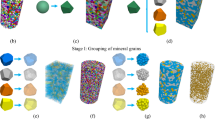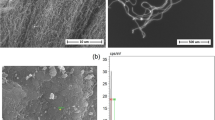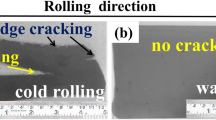Conclusions
The creep produced by a given effective load in magnesite-chromite specimens processed from finegrain bodies is governed by the microstructure after firing.
The disruption of the continuity of the material as a result of the development of wide cracks between the pores and the merging of individual pores into a group sharply increases the creep of the specimen at a given effective load until it is destroyed.
An increase in the pore diameter also results in discontinuities in the material and, consequently, in a sharp increase in creep at a lower porosity than in fine-pore specimens.
Since a microfissured structure results in higher creep and at the same time increases the spalling resistance [10, 11], peak values for these characteristics are incompatible in a single product so that they must be determined on the basis of compromise.
Similar content being viewed by others
Literature cited
I. G. Orlova, in: Trans. Ukrainian Institute of Refractories, Vol. 7 (54) [in Russian], Metallurgiya, Moscow (1963), pp. 77–82.
I. S. Kainarskii, I. G. Orlova, and R. E. Vol'fson, Ogneupory, No. 12, 26–34 (1969).
I. G. Orlova, I. S. Kainarskii, and R. E. Vol'fson, in; Theoretical and Technological Research in the Field of Refractories, Vol. 13 (60) [in Russian], Metallurgiya, Moscow (1970), pp. 74–90.
É. V. Degtyareva, I. S. Kainarskii, and I. I. Kabakova, Ogneupory, No. 4, 35–43 (1971).
B. Ya. Pines, Usp. Fizicheskikh Nauk, 52, No. 4, 501–559 (1954).
Ya. E. Geguzin, Macroscopic Flaws in Metals [in Russian], Metallurgizdat, Moscow (1962), 252 pages.
Ya. E. Geguzin, Physics of Sintering [in Russian], Nauka, Moscow (1967), 360 pages.
A. P. Panarin, Ogneupory, No. 2, 51–59 (1954).
I. S. Kainarskii, Ya. Z. Shapiro, and É. V. Degtyareva, Ogneupory, No. 1, 32–37 (1972).
I. S. Kainarskii and É. V. Degtyareva, in: Trans. Ukrainian Institute of Refractories, Vol. 4 (51) [in Russian], Metallurgizdat, Moscow (1960), pp. 5–17.
R. E. Vol'fson, I. G. Orlova, and I. S. Kainarskii, in; Theoretical and Technological Research in the Field of Refractories, Vol. 13 (60) [in Russian], Metallurgiya, Moscow (1970), pp. 91–102.
K. K. Strelov, Structure and Properties of Refractories [in Russian], Metallurgiya, Moscow (1972), 215 pages.
Author information
Authors and Affiliations
Additional information
Translated from Ogneupory, No. 11, pp. 41–45, November, 1973.
Rights and permissions
About this article
Cite this article
Degtyareva, É.V., Kainarskii, I.S. & Shapiro, Y.Z. Relation between the creep and porosity of refractories. Refractories 14, 706–710 (1973). https://doi.org/10.1007/BF01285067
Issue Date:
DOI: https://doi.org/10.1007/BF01285067




